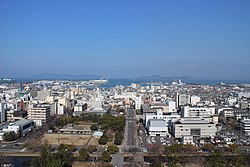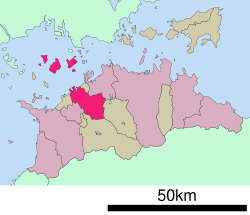|
Marugame, Kagawa
    Marugame (丸亀市, Marugame-shi) is a city located in Kagawa Prefecture, Japan. As of 1 October 2022[update], the city had an estimated population of 108,541 in 46101 households and a population density of 970 persons per km2.[1] The total area of the city is 111.79 square kilometres (43.16 sq mi). GeographyMarugame is located in north-center Kagawa Prefecture, on the island of Shikoku, facing the Seto Inland Sea to the north. The city covers the northeastern part of the Marugame Plain and part of the Shiwaku Islands. As with many other cities and towns in Kagawa Prefecture, there are many reservoirs. The Doki River flows from north to south through the center of the city, and to the south is Mount Tsutsumi, also known as Hatoko Fuji, one of the "Sanuki Seven Fujis". Mount Iino, nicknamed Sanuki Fuji and located on the border between Marugame and Sakaide, is another of the "Sanuki Seven Fujis".[2] Neighbouring municipalitiesKagawa Prefecture ClimateMarugame has a humid subtropical climate (Köppen Cfa) characterized by warm summers and cool winters with light snowfall. The average annual temperature in Marugame is 15.7 °C. The average annual rainfall is 1439 mm with September as the wettest month. The temperatures are highest on average in August, at around 26.6 °C, and lowest in January, at around 5.3 °C.[3] DemographicsPer Japanese census data,[4] the population of Marugame has recently plateaued after several decades of growth.
HistoryThe area of Marugame was part of ancient Sanuki Province and has been inhabited since ancient times, with many kofun burial mounds found within the city limits. From the Heian period onwards, it was noted as an entry point for pilgrims to the Kotohira-gū shrine. During the Edo Period, the area developed as the castle town for Marugame Domain, which was ruled for 210 years by the Kyōgoku clan. Following the Meiji restoration, the town of Marugame was established with the creation of the modern municipality system on February 15, 1890. It was elevated to city status on April 1, 1890, becoming the 53rd city in Japan. During the 1950s the southeast area of the city and some islands were amalgamated to form new parts of the city. On March 22, 2005, the towns of Ayauta and Hanzan (both from Ayauta District) were merged into Marugame to create the current expanded city of Marugame.
GovernmentMarugame has a mayor-council form of government with a directly elected mayor and a unicameral city council of 24 members. Marugame, together with Naoshima, contributes four members to the Kagawa Prefectural Assembly. In terms of national politics, the city is divided between the Kagawa 2nd district and the Kagawa 3rd district of the lower house of the Diet of Japan. List of mayors of Marugame (from 1899 to present)
EconomyMarugame has a mixed economy centered on agriculture (rice, vegetables, chicken, peaches) and manufacturing along a coastal belt of reclaimed land which contains a number of industrial parks, textile plants and shipyards. Traditionally, the city was noted for its production of uchiwa fans, claiming a 90% market share; however, due to mechanization and changes in fashion, only two workshops are left in the city. Due to its well-developed transportation network, industry is expanding, and the city is increasingly becoming a commuter town for neighboring Takamatsu. In 2015, Imabari Shipbuilding announced the construction of a large dry dock capable of building world-class containerships in Marugame.[5] EducationMarugame has 18 public elementary schools and eight public middle schools operated by the city government, and four public high schools operated by the Kagawa Prefectural Board of Education. In addition, there are one private middle school, two private high schools and two correspondence high schools. The prefecture also operates one middle school and one high school. TransportationRailways
Highways
Sister cities
Local attractions
Events
Notable people from Marugame
References
External links
|
|||||||||||||||||||||||||||||||||||||||||||||||||||||||||||||||||||||||||||||||||||||||||||||||||||||||||||||||||||||||||||||||





